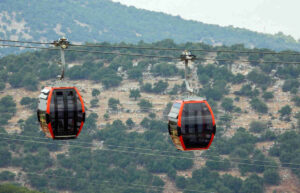To graphically illustrate what the Jordan Trail is, some travel experts call it “Jordan’s Camino de Santiago”. This route is not exactly a religious pilgrimage path (as the Spanish route mentioned is), but it has much in common with it. In this post, we tell you exactly what it is so you can understand if this challenge is right for you.
Here’s the Jordan Trail
The Jordan Trail is “a journey through the history of Jordan and an encounter with its varied culture,” in the words of its own website. It is a 675 km route that crosses the country from north to south, from Um Qais to Aqaba, through different stages divided into 40 days, to get to know a total of 75 towns and cities, as well as four Biosphere Reserves.
It is intended as a walking route, as some sections take the traveler through rugged and rocky areas, where a bicycle or horse cannot effectively pass. Although its signage is not exactly exhaustive, the association that promotes the route does provide orientation resources such as maps and GPS tracks to follow the route without getting lost.
Jordan Trail Route
The base proposal of the Jordan Trail is to complete this great journey in about 40 days, divided into 8 major geographical sectors, as shown below, with their respective attractions:
- From Um Qais to Ajloun (80 km): this sector has significant Roman remains from the ancient Decapolis, the Ziglab ecopark, a Byzantine monastery linked to the prophet Elijah, the imposing medieval castle of Ajloun, and rural tourism communities.
- From Ajloun to As-Salt (62 km): the picturesque city of As-Salt (with an Ottoman air), the King Talal Dam, or significant local economy projects, such as the Carakale craft brewery, are some proposals.
- From As-Salt to Zarqa Ma’in (84 km): this section, which runs through areas around Amman not frequented by tourists, such as the rock columbarium of Iraq Al-Ameer or the waterfalls of Zarqa Ma’in, as well as stretches of Roman road and the Dead Sea environment.
- From the three Wadis to Karak (75 km): the Great Canyon of Jordan (Wadi Mujib) is a geographic feature that marks this section, as well as the famous Crusader castle of Karak.
- From Karak to Dana (83 km): the Dana Biosphere Reserve is a fundamental stop on this section, which also includes ancient sites from the Metal Age.
- From Dana to Petra (84 km): undoubtedly, the most popular and anticipated section by many, as it runs through the famous Nabatean city of Petra, as well as Little Petra, the canyons of its surroundings, and ecotourism projects that integrate into the landscape and are inspired by Bedouin civilization.
- From Petra to Wadi Rum (90 km): another very popular section, as it reaches and crosses the Wadi Rum desert, with its imposing rock formations in the shape of bridges and whimsical mountains.
- From Wadi Rum to Aqaba (112 km): the last and longest section of the Jordan Trail, famous because it roughly follows the route of Lawrence of Arabia during the Arab Revolution. Reaching the Red Sea and its beautiful crystal clear waters is undoubtedly a well-deserved reward.
As you can see on our website, the circuits of Jordania Exclusiva are of a different nature: shorter and prioritizing comfort and quality in road transport. However, if you are passionate about these experiences and want to do any of the indicated stages, you can tell us your idea. Some of the stages of the Jordan Trail overlap with our own routes, so it may be feasible to integrate a day of trekking during your trip to feel firsthand the excitement of walking through deep Jordan.



